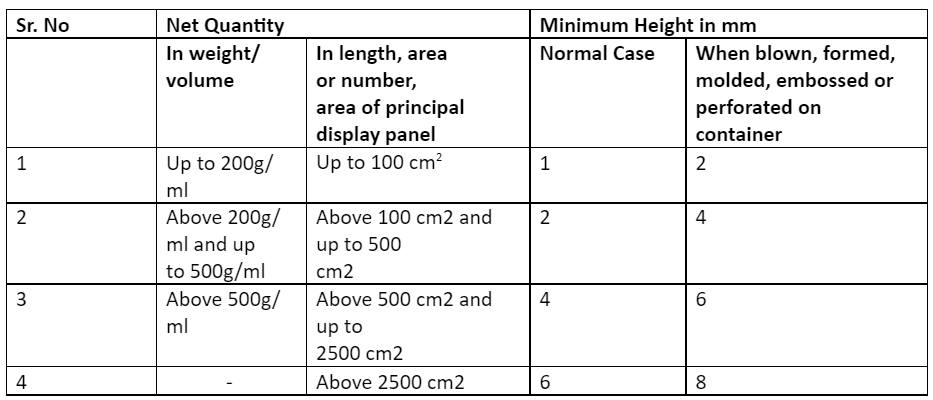Legal Metrology Rules You Must Know For A Food Label
July 20, 2022

Legal Metrology rules are a set of guidelines issued by the Department of Consumer Affairs that deal with measurements and measuring instruments. Its objective is to bring uniformity and accuracy in weights and measures across all products.
Weights and measures are an intricate part of food products as well. Hence the Legal Metrology Act, 2009 is applicable to all food products.
What are the various rules under Legal Metrology?
The Legal Metrology Act, 2009 came into effect from 1st April 2011. Under this Act the following seven Rules are prescribed:
The Legal Metrology (General) Rules, 2011- Specifies weights and measures in general along with describing the instruments and its verification.
The Legal Metrology (Packaged Commodities) Rules, 2011- Applicable to all packaged commodities including Food Products.
The Legal Metrology (Approval of Models) Rules, 2011- This Rule is specifically to all Manufacturers and Importers manufacturing the weights and measures.
The Legal Metrology (National Standards) Rules, 2011- These Rules describe the provisions at National Level for various prototypes and weights maintained in National Laboratories.
The Legal Metrology (Numeration) Rules, 2011- This Rule specifies the manner in which numbers should be written.
Indian Institute of Legal Metrology Rules, 2011- This Rules specifies courses and qualifications for Legal Metrology Officers at the Indian Institute of Metrology, Ranchi.
The Legal Metrology (Government Approved test Centre) Rules, 2013- These are for private persons seeking approval and verification of Government Approved test Centres for some of the weights in measures.
Essentials of the Legal Metrology (Packaged Commodities) Rules, 2011
The Rules under Legal Metrology (Packaged Commodities) for a Food label can be grouped into the following:
Name and Address of the Manufacturer
Net Quantity
Date indications
Retail Sale Price
Area, Size, Letter of the Principal Display Panel
Declarations on Wholesale Package
1. The Name and Address of the Manufacturer
“Manufacturer” in relation to any commodity in packaged form, means a person who, or a firm which, produces, makes or manufactures such commodity and includes a person, firm which puts, or causes to be put, any mark on any packaged commodity, not produced, made or manufactured by him or it, and the mark claims the commodity in the package to be a commodity produced, made or manufactured by such person or firm, as the case may be.
The name and complete address of the manufacturer or the manufacturer and packer, when the manufacturer is different from the packer and the importer as well should be declared clearly. Here complete address means the following
The full postal address where the manufacturing factory is located
City and State
Postal Index Number (PIN) Code.
2. Net Quantity

“Net quantity”, in relation to a commodity contained in a package, means the quantity by weight, measure or number of such commodity contained in that package, excluding the packaging or wrapper. The net quantity needs to be mandatorily declared by the food manufacturer in terms of accurate weights or numbers as the case may be.
The area surrounding the net quantity declaration should not contain any written information such as above and below by a space equal to height of the numeral and right and left by twice as much space as the height of numeral. The net quantity weight should exclude the wrapper or the packaging and give accurate information of the weight of the commodity. The declaration of quantity for packages having capacity less than 5 cubic cm or less should be made on a tag, tape, card or other similar device affixed to the container. Only the international System of Units should be used for declaring net quantity.
The net quantity declaration should not contain words that display exaggerated or misleading net quantity indications. Example- like-'minimum', 'not less than', 'average', 'about', 'approximately' or other words of a similar nature.
2.1. Units of Net Quantity

3. Date Indications

Every Packaged Commodity should declare the month and year of Manufacture. These may be expressed in words or numerals. The Food Safety and Standards Authority of India (FSSAI) Labelling and Display Regulations of 2020, clearly indicates what dates should be declared on the food product.
4. Retail Sale Price
“Retail sale price” means the maximum price at which the commodity in packaged form may be sold to the consumer.
The manner in which the declaration should be written is as follows:
Maximum or Max. retail price Rs/₹ .......inclusive of all taxes
MRP Rs/₹ .........incl., of all taxes
In the case of packagings such as bottles, used in soft drinks or beverages, the retail sale price should be indicated on the crown of the cap in the manner as mentioned above.
The declaration of the retail sale price and net quantity should be printed on the pack in contrasting colour with the background of the label. Provided that, if the label information is blown, and formed on a glass or plastic material then a contrasting background is not required. Also, if such declaration is in the form of a hand script, it should be clear and legible.
5. Area, Size, Letter of the Principal Display Panel
“Principal display panel” means that part of the container/package which is intended or likely to be displayed or presented or shown or examined by the customer under normal and customary conditions of display, sale or purchase of the food article contained therein.
All the required information should be correctly displayed on the Principal Display Panel and should be legible and prominent. This information should be in either English or Devnagri Script (Hindi). In case an outside package is provided for any product, such a package should also have all the required mandatory information unless such a pack is transparent and the inside labelling information is visible to the consumer.
Minimum Height of Numeral

6. Declarations on Wholesale Package
“Wholesale package” means a package containing- a number of retail packages, where such first mentioned package is intended for sale, distribution or delivery to an intermediary and is not intended for sale directly to a single consumer.
All wholesale packages should contain the following declarations made in a legible form:
The name and complete address of the manufacturer or packer or importer
The identity of the commodity
The total number of retail sale packs present in the wholesale pack
All food products must follow FSSAI regulations along with the above discussed Legal Metrology Rules for their food product to be 100% compliant.
Frequently Asked Questions
What is the difference between a multiunit package and a wholesale package?
“Multi-unit package” means a package containing two or more individually packaged or labelled units of the same food commodity of identical and/or different, net quantity intended and displayed for retail sale either in individual units or package as a whole and complies with the general labelling requirement.
On the other hand, the wholesale package also means individually packaged units of the same food commodity, however, intended to be distributed to an intermediary and not for direct sale to a single consumer.
What is the difference between Net weight and Drained weight?
Drained Weight is the weight of solids remaining after the liquid is removed from it. For example in the case of canned foods. On the other hand, the net weight is the complete weight of the food commodity. Hence in the case of canned products, net weight may not give you the full picture, but the Legal Metrology rules mandates listing of the net weight of the commodity.
What are the overlapping regulations of Legal Metrology rules and FSSAI?
FSSAI being the apex food regulatory authority of India has stated regulations on food products covering all aspects, including those given in the Legal Metrology Rules.
Some of the overlapping regulations present in FSSAI guidelines are as follows:
Name and Complete Address of the Manufacturer- FSSAI mentions the declaration of the Name and address of the Brand Owner, whether or not he/ she is the manufacturer or packer or importer.
Date Marking- FSSAI clearly defines Best before dates, Expiry dates and other dates to be declared on the food product. Only the Best before date is optional to be declared.
Principal Display Panel- All the declarations under PDP are given by FSSAI, along with numeral height indications.
Net quantity, Retail sale price and declaration on the wholesale pack – given under Legal Metrology rules in more detail.
References:
1. Department of Consumer Affairs. Legal Metrology. Overview.
2. Department of Consumer Affairs. Legal Metrology. The Legal Metrology (Packaged Commodities) Rules, 2011.
3. The Food Safety and Standards Authority of India (FSSAI). Regulations. Food Safety and Standards (Labelling and Display) Regulations.

Rashida Vapiwala (Founder at LabelBlind®, Food Label Specialist, Ph.D (Food Science and Nutrition))
Rashida is passionate about solving problems for the food industry using technology. She loves creating tech-led solutions in the space of Nutrition.
